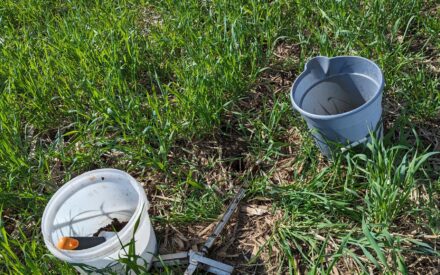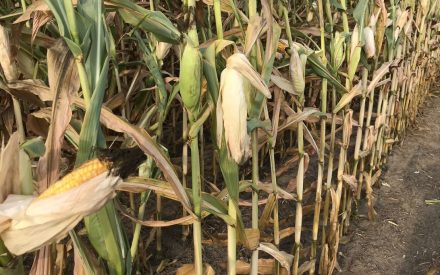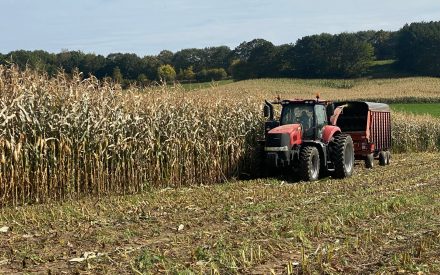Farming is a business that cannot avoid weather risks. A significant challenge farmers face is dealing with excessive water, especially flooded and saturated soil. The impact of excess water on crop growth and yield is influenced by crop type, soil characteristics, duration of excess water or flooding, initial soil water and nitrogen status of the soil before flooding, crop stage, soil and air temperature, and other factors.
Understanding wet soil
An ideal soil for crop production has 50% pore space, 45% mineral and 5% organic matter. Ideally, the pore space is occupied by 50% air and 50% water space. When excessive rain occurs, saturated soil refers to a soil in which the pore space is fully occupied with water. Sandy soils can typically hold 1 inch of water per foot of soil. Medium and fine-textured soils- hold 2.5 to 3 inches of water per foot of soil. When soils reach capacity, the water ponds and floods areas of the field which were usually dry. It can result from one extreme event or occur over several days or weeks of excessive rainfall.

Effects of Flooding on Crops
Flooding limits the amount of oxygen and nutrients available to plant roots. Whether a seed or seedling survives flooding is based on the length of time that flooding lasts and the soil temperature. Seed and small seedlings can usually survive 2-4 days, or more than a week if temperatures are cool and leaves are exposed above the water. Plants respire faster at elevated temperatures (upper 80s and 90s) and can be killed in as little as a day. Here is more detailed crop info:
- Corn
- V1-V6 can tolerate flooding for 2-4 days
- After V6 are more tolerant (4-6 days)
- More about flooding effects on corn
- Soybean
- Seedlings can survive flooding for 2-4 days
- Older soybean plants can tolerate 5-7 days of flooding
- More about assessing flood damage to soybean
- Wheat
- Young wheat plants can die within 1-3 days of flooding
- Mature wheat plants cannot withstand more than 3-5 days of flooding
- Forages
Note: Expect all of the above to be worse in warmer temperatures and heavy clay soils
Leaching, Denitrification and Soil Loss
Nitrogen leaching occurs when rain (or irrigation) exceeds the soil’s ability to hold water in the root zone. Wonder if you have had leaching? Compare your local rainfall totals to the number of inches of water that your soil can hold using the most recent Wisconsin Ag Weather Outlook.
As stated above, sandy soils can typically hold 1 inch of water per foot of soil while medium and fine textured soils- hold 2.5 to 3 inches of water per foot of soil. Read more about soil texture here.
The temperature at the time of flooding influences nitrogen fertilizer breakdown by speeding up microbial activity when it is warm or slowing it down if it is cooler. At a soil temperature of 55-65 °F, approximately 2% to 3% of soil nitrate is lost per day. Above 65 °F, approximately 4% to 5% is lost daily.
Flooding can erode soil and nutrients from the crop field as water moves across the soil surface. Soil that is saturated will not allow more water to infiltrate; any rain falling on the soil surface will run off, carrying soil with the running water. Eroded soils often result in stunted growth and lower yields.
Additionally, erosion can cause soil crusting making it difficult for seedlings to emerge. If soil crusting occurs, consider running through the field with a rotary hoe or spike tooth drag to break up a surface crust. Erosion can move soil and nutrients from steep areas of a field to low-lying areas of a field. Topsoil can be completely removed from the field by water erosion. Losing topsoil is costly.
According to calculations done by soil scientist Francisco Arriaga of the University of Wisconsin, 1 ton of topsoil soil contains:
- 2 pounds of nitrogen
- 9 pounds of phosphorus
- 31 pounds of potassium
If the average soil loss is 5.8 tons, that is $77.02 per acre in lost nutrients, not to mention loss of future productivity. That is a loss of $287 per year per acre, which amounts to $43,050 per year on a 150-acre farm!
When soils are flooded or saturated for 1-2 days, the soil bacteria start converting nitrate into N gas during denitrification. This is also temperature dependent, warmer temperatures will increase the rate of denitrification.
If you applied 150 pounds of 28% UAN as side-dress 3 weeks ago, and the soils remained saturated for 6 days above 65 degrees, you could expect 20 or 30 pounds per acre denitrification loss. (Note that this is only an estimate.)
Disease and flooding
Floodwaters can erode soil and expose roots, making them vulnerable to disease and injury. This can hinder the plant’s stability and its ability to absorb nutrients.
Standing water creates a conducive environment for pathogens, leading to increased incidents of root rot, mold, and other water-borne diseases. Plan to scout fields 2-3 days after water recedes.
Best management strategies for flooded soils in Wisconsin
Select a nitrogen fertilizer based on your soil’s holding capacity and environmental conditions. Slow-release nitrogen fertilizers or nitrification inhibitors which can reduce nitrogen loss by slowing down the conversion of ammonium to nitrate. Incorporating fertilizers into the soil rather than surface application can reduce losses.
Also, consider splitting nitrogen fertilizer applications on sandy soils to reduce the risk of nitrogen leaching.
Maintaining or adding proper conservation drainage systems, such as grassed waterways, tile drainage, and retention ponds can help manage excess water and prevent prolonged flooding or soil saturation. Practices like no-till or minimum tillage, use of cover crops, or adding perennials in the crop rotation can help improve soil structure, reduce compaction, and enhance water infiltration. Increasing the amount of organic matter in the soil can also help improve water-holding capacity.

Key takeaways
Flooding and saturated soil present significant challenges to agricultural crop production. Different crops have varying levels of tolerance to wet soils, with most crops experiencing damage or death within 1-7 days of flooding depending on the species and growth stage and environmental conditions. However, with proper management practices and adaptive strategies, farmers can mitigate the adverse effects and maintain crop health and yield.
References
Laboski, Carrie. 2011. Assessing the Potential for Nitrogen Loss from Heavy Rainfalls. UW–Madison Integrated Crop and Pest Management.
Tubaugh, Amanda. 2023. The true cost of soil erosion. Farm and Dairy.

 ▶ AI in Agriculture
▶ AI in Agriculture ▶ Evaluating MRTN Rates for Corn Grain and Silage After Manure Application
▶ Evaluating MRTN Rates for Corn Grain and Silage After Manure Application ▶ Practices to Optimize the Nutritive Value of Corn Silage
▶ Practices to Optimize the Nutritive Value of Corn Silage ▶ Explore the New Corn Silage Dry Down Monitoring Tool
▶ Explore the New Corn Silage Dry Down Monitoring Tool


